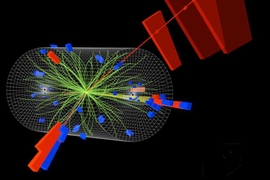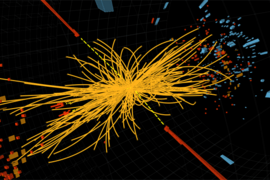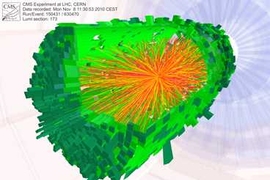In research conducted by a group led by MIT Laboratory for Nuclear Science researcher and associate professor of physics Markus Klute, electroweak productions of same-sign W boson pairs were observed, the first such observation of its kind and a milestone toward precision testing of vector boson scattering (W and Z bosons) at the Large Hadron Collider (LHC).
The LHC at CERN in Geneva, Switzerland, was proposed in the 1980s as a machine to either find the Higgs boson or discover yet unknown particles or interactions. This idea, that the LHC would be able to make a discovery, whatever that might be, is called by theorists No-lose Theorem, and is connected to probing the scattering of W boson pairs at energies above 1 teraelectronvolt (TeV). In 2012, only two years after the first high-energy collision at the LHC, this proposal paid huge dividends when the Higgs boson was discovered by the ATLAS and Compact Muon Solenid (CMS) collaborations.
According to CERN, the CMS detector at the LHC utilizes a massive solenoid magnet to study everything from the Higgs boson to dark matter to the Standard Model. CMS is capable of generating a magnetic field that is approximately 100,000 times that of Earth. It resides in an underground cavern near Cessy, France, which is northwest of Geneva.
The main goal of a recent measurement by CMS was to identify W boson pairs with the same sign (W+W+ or W-W-) produced purely via the electroweak interaction and probing the scattering of W bosons. The result does not unveil physics beyond the Standard Model, but this first observation of this process marks a starting point for a field of study to independently test whether the discovered Higgs boson is or is not the particle predicted by Robert Brout, François Englert, and Peter Higgs. It is anticipated that the rapidly growing data sets available at the LHC will further knowledge along these lines. Studies show that the high luminosity LHC will likely allow the direct study of longitudinal W boson scattering.
“The measurement of vector-boson scattering processes, like the one studied in this paper, is an important test bench of the nature of the Higgs boson, as small deviations from the Standard Model expectation can have a large impact on event rates,” Klute says. “While challenging new physics models, these processes also allow a unique model-independent measurement of Higgs boson couplings to the W and Z boson at the LHC.”
“The observation of this vector-boson scattering process is an important milestone toward future precision measurements,” Klute says. “These measurements are very challenging experimentally and require theoretical predictions with high precision. Both areas are pushed forward by the published results.”
The work, while within CMS, was performed by MIT and included Klute, his students Andrew Levin and Xinmei Nui, and research scientist Guillelmo Gomez-Ceballos, along with University of Antwerp colleague Xavier Janssen and his student Jasper Lauwers.
The work has been published in Physical Review Letters.
This research was funded with support from U.S. Department of Energy.

![“[MIT] is a fantastic place,” says associate professor Markus Klute, a member of the Laboratory of Nuclear Science. “Where else in the world do you get this amount of freedom?”](/sites/default/files/styles/news_article__archive/public/images/201707/MIT-Klute-Markus-A1.jpg?itok=IpIolYKm)








